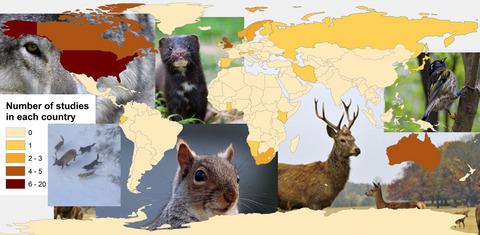当前位置:
X-MOL 学术
›
Mammal Rev.
›
论文详情
Our official English website, www.x-mol.net, welcomes your
feedback! (Note: you will need to create a separate account there.)
A systematic review of adaptive wildlife management for the control of invasive, non‐native mammals, and other human–wildlife conflicts
Mammal Review ( IF 4.3 ) Pub Date : 2020-04-01 , DOI: 10.1111/mam.12182 Suzanne Richardson 1, 2 , Aileen C. Mill 3 , Darryl Davis 4 , David Jam 2 , Alastair I. Ward 1
Mammal Review ( IF 4.3 ) Pub Date : 2020-04-01 , DOI: 10.1111/mam.12182 Suzanne Richardson 1, 2 , Aileen C. Mill 3 , Darryl Davis 4 , David Jam 2 , Alastair I. Ward 1
Affiliation

|
1. We are entering an era where species declines are occurring at their fastest ever rate, and the increased spread of non-native species is among the top causes. High uncertainty in biological processes makes the accurate prediction of the outcomes of management interventions very challenging. Adaptive management (AM) offers solutions to reduce uncertainty and improve predictability so that the outcomes of interventions can continuously improve. 2. We quantitatively assess the extent to which AM is used for managing vertebrates, with a focus on invasive non-native species (INNS). Using the Web of Science, we evaluated 3992 articles returned by the search terms ‘adaptive management’ or ‘adaptive harvest management’ against seven recommended elements of AM (engagement with stakeholders, defining objectives, forecasting and estimating uncertainty, implementing management, monitoring populations, adjusting management in response to monitoring, and improving forecasting and reducing uncertainty in response to monitoring populations). 3. The use of AM for vertebrates was reported in 56 (1%) of the evaluated studies; including four for managing INNS. Of these, ten studies excluding INNS and no studies of INNS management implemented all seven recommended elements of AM. Those elements infrequently implemented were: the use of analysis or models to forecast and represent uncertainty (44%) and the feedback of monitoring data to improve forecasting and reduce uncertainty (25%). 4. Complete active AM has rarely been implemented and reported for managing INNS, despite the significant advantages it offers. Among studies purporting to have implemented AM, most did not use analyses or models to forecast and represent uncertainty, while most defined objectives, implemented management, and monitored populations. 5. Improvements to ongoing control programmes and much broader adoption of the AM approach are required to increase the efficiency and success of INNS management campaigns and reduce their negative impacts on native species.
中文翻译:

用于控制入侵性、非本地哺乳动物和其他人类与野生动物冲突的适应性野生动物管理的系统评价
1. 我们正在进入一个物种以有史以来最快的速度减少的时代,非本地物种的扩散增加是主要原因之一。生物过程的高度不确定性使得准确预测管理干预的结果非常具有挑战性。适应性管理 (AM) 提供了减少不确定性和提高可预测性的解决方案,以便干预的结果可以不断改善。2. 我们定量评估了 AM 用于管理脊椎动物的程度,重点是侵入性非本地物种 (INNS)。使用 Web of Science,我们根据 AM 的七个推荐元素(与利益相关者的接触、定义目标、预测和估计不确定性、实施管理,监测种群,根据监测调整管理,根据监测种群改进预测和减少不确定性)。3. 56 项(1%)的评估研究报告了 AM 用于脊椎动物;包括四个用于管理 INNS。其中,不包括 INNS 的 10 项研究和没有关于 INNS 管理的研究实施了 AM 的所有七个推荐要素。那些不常实施的要素是:使用分析或模型来预测和表示不确定性 (44%) 以及监测数据的反馈以改进预测和减少不确定性 (25%)。4. 尽管完全主动 AM 提供了显着的优势,但它很少被实施和报告用于管理 INNS。在声称已实施 AM 的研究中,大多数没有使用分析或模型来预测和表示不确定性,而大多数明确的目标、实施的管理和监测的人口。5. 需要改进正在进行的控制计划并更广泛地采用 AM 方法,以提高 INNS 管理活动的效率和成功,并减少它们对本地物种的负面影响。
更新日期:2020-04-01
中文翻译:

用于控制入侵性、非本地哺乳动物和其他人类与野生动物冲突的适应性野生动物管理的系统评价
1. 我们正在进入一个物种以有史以来最快的速度减少的时代,非本地物种的扩散增加是主要原因之一。生物过程的高度不确定性使得准确预测管理干预的结果非常具有挑战性。适应性管理 (AM) 提供了减少不确定性和提高可预测性的解决方案,以便干预的结果可以不断改善。2. 我们定量评估了 AM 用于管理脊椎动物的程度,重点是侵入性非本地物种 (INNS)。使用 Web of Science,我们根据 AM 的七个推荐元素(与利益相关者的接触、定义目标、预测和估计不确定性、实施管理,监测种群,根据监测调整管理,根据监测种群改进预测和减少不确定性)。3. 56 项(1%)的评估研究报告了 AM 用于脊椎动物;包括四个用于管理 INNS。其中,不包括 INNS 的 10 项研究和没有关于 INNS 管理的研究实施了 AM 的所有七个推荐要素。那些不常实施的要素是:使用分析或模型来预测和表示不确定性 (44%) 以及监测数据的反馈以改进预测和减少不确定性 (25%)。4. 尽管完全主动 AM 提供了显着的优势,但它很少被实施和报告用于管理 INNS。在声称已实施 AM 的研究中,大多数没有使用分析或模型来预测和表示不确定性,而大多数明确的目标、实施的管理和监测的人口。5. 需要改进正在进行的控制计划并更广泛地采用 AM 方法,以提高 INNS 管理活动的效率和成功,并减少它们对本地物种的负面影响。











































 京公网安备 11010802027423号
京公网安备 11010802027423号